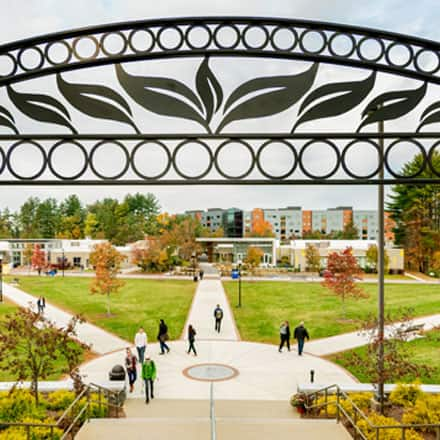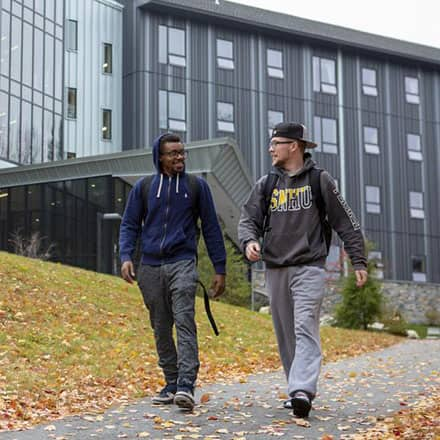SNHU School Of Engineering, Technology and Aeronautics Building Named to Honor President Paul LeBlanc

In recognition of 21 years of dedicated leadership, this week the Southern New Hampshire University (SNHU) Board of Trustees moved to name the School of Engineering, Technology and Aeronautics (SETA) facility, the Paul J. LeBlanc Hall, honoring the indelible impact President Paul LeBlanc has made on the university. Late last year, LeBlanc announced his decision to step down from his role at the end of June. A surprise ceremony was held Thursday on the Manchester, New Hampshire, campus to unveil the naming of the SETA facility for LeBlanc. It is one way the SNHU community is coming together in LeBlanc’s final weeks as president.

The unveiling, led by incoming President, Lisa Marsh Ryerson, was a complete surprise for LeBlanc, who described the moment by sharing, “I'm incredibly honored and this was a great surprise. I would have been happy if they just kept my name on the racquetball court.
“This is my favorite building on campus and it’s the greatest honor. I promised I’d stay out of Lisa’s way, but I’m going to come visit my building from time to time” added LeBlanc.
Under LeBlanc’s leadership since 2003, SNHU has transformed from a small regional university to an internationally known leader in higher education, growing from 2,500 students to more than 225,000 learners. While LeBlanc is widely known as the driving force behind the growth of SNHU’s online programs, his strong connection to campus can be told through stories like the creation of the SETA program.
SETA was established in 2017 after the sudden closure of Daniel Webster College (DWC) to expand access to affordable and accessible engineering degree programs in the New England region. Under LeBlanc's leadership, SNHU entered into a “teach-out” agreement to allow DWC students to complete their programs at SNHU. Dr. Kyle Viator, dean of SETA described feeling impressed by LeBlanc’s actions during the DWC transition and its lasting impact on making STEM degrees more accessible in the region.
“It really is a beautiful story of us going in and doing the right thing and being able to expand our campus options for our students as a result,” Viator said. “The DWC employees were hired, the students were taken under our wing, and we were able to get them to graduation that year or transition them back to campus. That’s almost unheard of and the fact that we were then able to take the best that Daniel Webster College had, move it up to our campus in Manchester, New Hampshire, and then be able to build these outstanding programs and build SETA. It has had such an impact on the New Hampshire community and STEM options that we offer here in the state. We’re very grateful to Paul here in SETA for the work that he did with Daniel Webster College and for the direction that he set us off on all those years ago.”
In a 2017 Penmen Press article about upcoming campus projects at the time, LeBlanc described the plans for the SETA building as being “really well designed for innovation and design thinking and creativity,” something Viator remembers fondly.

“I think this happens to be one of Paul’s favorite places on campus,” Viator said of the SETA facility. “We see him here often because it encapsulates 20 years of what he’s seen on campus and his vision for what the faculty and student interactions could be and how important space is in building those relationships.”
While SETA has existed since the teach-out of all DWC programs, its facility — located in the heart of the SNHU campus — was officially opened in 2020. The 67,000-square-foot academic building is the official home of SNHU’s on campus SETA programs, helping to prepare students for in-demand STEM careers.
Viator, who first met LeBlanc as a student, describes having had a front row seat to SNHU’s expansion and LeBlanc’s legacy of leading in service of the changing needs of learners.
“This facility is a collaborative workspace that encourages project-based learning and strong faculty and student interactions. That’s what Paul wanted for SETA and that’s what he wanted for the campus,” Viator said. “This isn’t just an engineering and technology building, it’s a building for everyone on campus. We have art classes here, education classes, math classes, so it really is a place for all of campus to come and learn.”
As LeBlanc reflected on his last week at SNHU, he shared, “I’m incredibly moved by all of this and often say that the key to a happy life is to find work you love, do it with people you love, for people you love, and I’ve had all three of those in my time here at SNHU. Thank you.”
About Southern New Hampshire University: Southern New Hampshire University (SNHU) is a private, nonprofit institution with a 90-year history of educating traditional-aged students and working adults. Now serving more than 180,000 learners worldwide, SNHU offers approximately 200 accredited undergraduate, graduate and certificate programs, available online and on its 300-acre campus in Manchester, NH. Recognized as one of the “Most Innovative" regional universities by U.S. News & World Report and one of the fastest-growing universities in the country, SNHU is committed to expanding access to high quality, affordable pathways that meet the needs of each learner. Learn more at www.snhu.edu.
Contact:
Siobhan Lopez
Southern New Hampshire University
Cell: 603.567.4589
s.lopez@snhu.edu
Explore more content like this article

President's and Dean's List Fall 2024

President's and Dean's List Summer 2024

SNHU Recognized as a Top Employer in Higher Ed, Leader in Innovation
About Southern New Hampshire University

SNHU is a nonprofit, accredited university with a mission to make high-quality education more accessible and affordable for everyone.
Founded in 1932, and online since 1995, we’ve helped countless students reach their goals with flexible, career-focused programs. Our 300-acre campus in Manchester, NH is home to over 3,000 students, and we serve over 135,000 students online. Visit our about SNHU page to learn more about our mission, accreditations, leadership team, national recognitions and awards.

